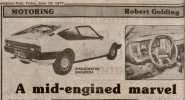Back to the original idea behind this thread..... Below are my father's pre-war and wartime cars. Obviously I know whose they were at one time - but they all went on to have other owners later and, with one exception, they had had other owners previously.
His first car after lethal motorbikes, a Morris Cowley, OP 585, photographed Croydon Road, Erdington, 1929

Traded in, May 1934, for a black 1932 Morris Major (6-cyl, 13.9 h.p.) , OJ 577, photographed South Devon, ca 1935. The only family memory of this car relates to a persistent smell of bad eggs, probably emanating from the battery.

That traded in, 1937, for a black 1936 Ford V8, again photographed South Devon 1938. The number plate is obscured by a reluctant two-year-old having his first (and last) riding lesson. But it was COH 619. The horse rider has just one memory of being in the back of this car but not that particular occasion.

Disaster at around that time, probably 1937. But car later restored to new after about three weeks and continued to serve. Photographed at Cutler's Garage, Streetly.

But then, you should have seen the other bloke! (A coming together at the Queslett Road and Chester Road (Moorcroft) crossroads one night on the way to the flicks - probably the Kingstanding Odeon - my father, sister and brother, thankfully uninjured, as was the inebriated Vauxhall driver. No seat belts in those days. Hence the V8 windscreen).

V8 traded in for new black (what else?)10 h.p. Ford Prefect, FOK 535, early 1940, probably one of the last cars to be sold in Brum before they stopped manufacturing. Acquired on the grounds that petrol supply was clearly going to become difficult as and when the war hotted up and a big car was not the thing to have. Photographed here in 1943. Dad had a necessary user's petrol ration and so the car (unlike many others which were laid up for the duration) served him loyally throughout the war and for years afterwards.

And again, looking a bit battered and corroded (but at least showing its registration number), in around 1947. I have many memories of that car, from its arrival to its departure, including all its long journeys which, in those days, were a somewhat more challenging adventure than today's. The car couldn't be replaced until 1952 because the car trade was a racket until around 1952/53 when supplies started to become available to those not "in the know".

Very doubtful if any of these ever cropped up anywhere else, but you never know....
Chris
(Additional information added 6th August 2020)












